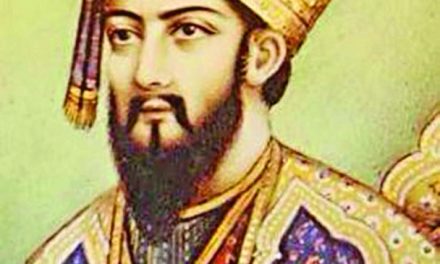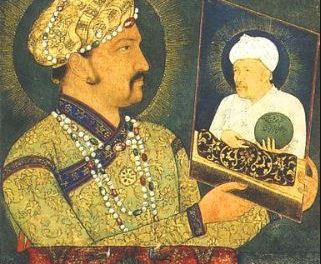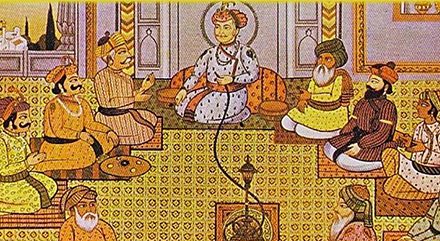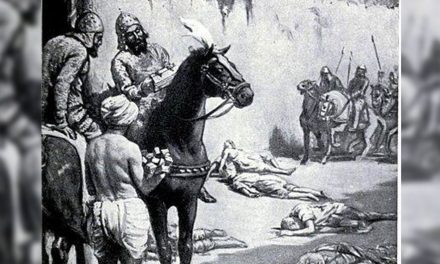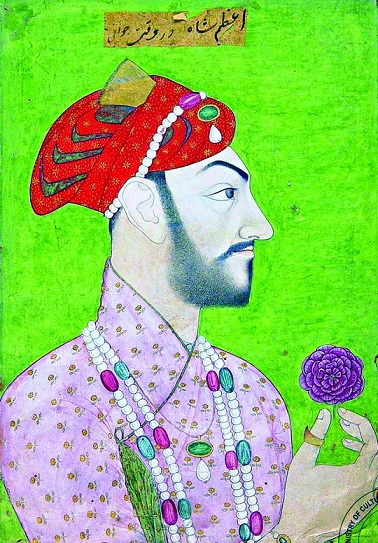
The Lalbagh fort that stands in the heart of Dhaka with all its glory was once started by the favorite son of the great Mughal Emperor Aurangzeb. Though incomplete, it is still one of the most prominent landmarks in Dhaka, constructed by the Mughal Prince and later Emperor, Muhammad Azam Shah Bahadur.
Muhammad Azam Shah Bahadur was the third son of Emperor Aurangzeb and his first wife and chief consort Dilras Banu Begum, daughter of Shahnawaz Safvi, a Persian nobleman. He was an amiable and adventurous young man and his chivalry and excellence made him his father’s favorite. Aurangzeb considered Azam to be more of a companion than a son. Despite Aurangzeb being a perfectionist, Azam never failed to please his father.
He was authorized to lead several conquests of forts in Rajputana, Gujrat, and Deccan. After the death of his predecessor, Azam Shah was made the Subahdar of Berar Subah, Malwa and Bengal, in 1677 and stayed in Dhaka till 1679. He lived in Dhaka during this time and had immensely contributed to the infrastructure of the city.
Before his reign, canals were used by people to travel from point A to point B. Small towns had narrow streets for people to walk through. The city did not have proper broad roads for transportation. Azam Shah changed this. He created solid concrete roads wide enough for horses, even elephants, to travel through. That is when animals became a popular form of transport in Dhaka. He cleared jungles and improved the city he called home at that time.
The prince started building the Lalbagh Fort during that period as well. It was not just a fort, in fact, it was a palace-fortress which he was building to reside in. The Bengal Subah was one of the richest at the time in terms of resources and wealth and Aurangzeb wanted Azam to permanently live there as the viceroy of the flourishing province. It is said that Azam Shah got married to Iran Dukht ( titled Bibi Pari) during his stay in Dhaka.
She was the daughter of Aurangzeb’s maternal uncle Shaista Khan, the governor of Dhaka at the time. In fact, one of the main attractions of the Lalbagh Fort is her tomb. When Azam Shah decided to build the fort he did not know that he would have to leave the province without completing it. Perhaps, the Lalbagh fort would have been one of the greatest monuments in the province if the prince stayed there to supervise the construction.
Aurangzeb called for his son within 15 months of his stay in Dhaka and he left immediately, handing his responsibilities over to Shaista Khan. He assigned Shaista Khan to complete the construction of the fort. Soon after he left, his wife met an untimely death which left her father heartbroken. Bibi Pari’s tomb was then constructed within the fort as by Shaista Khan.
However, there are a lot of controversies regarding Bibi Pari and her tomb. There is no evidence if the prince was actually betrothed to Shaista Khan’s daughter. The idea of their marriage is somewhat questionable since she was not Azam’s cousin, rather she was his paternal aunt. Also, Azam Shah already had four wives at the time, his first wife being Jahanzeb Banu Begum, daughter of Aurangzeb’s eldest brother, Dara Shikoh.
About the tomb, some assume that it does not carry Bibi Pari’s body rather there lies the body of Azam Shah’s second wife, the Ahom princess, Ramani Gabharu. Ramani Gabharu, later renamed as Rahmat Banu Begum was the child of the Ahom lord, Swargadeo Jayadhwaj Singha. She was brought into Mughal vicinity at the young age of nine by Mir Jumla after he conquered Gouhati.
Aurangzeb took responsibility for her upbringing and under his care, the Buddist girl converted to Islam after her majority. Later, Aurangzeb decided to get her married to his beloved son Prince Azam. There are stories that since she was extraordinarily beautiful and enchanting, she was one of the prince’s favorites and he affectionately called her Bibi Pari.
There is not much found about her life in Mughal history aside from the fact that she did come to Dhaka with the prince. Some writers say that she suffered from a disease in Dhaka and later died there and her tomb was actually the one that resides in the Lalbagh fort. Whether Ramani Gabharu or Iran Dukht is Bibi Pari, this controversy will always play a significant role in the intriguing minds. During Azam’s viceroyalty, there were troubles in Assam. The prince skillfully captured Gouhati with his army and renamed it Azamgarh. Aurangzeb was thoroughly impressed by this, which encouraged Azam to prepare to attack Arakan.
At this time, the Hindu princes of India, especially those of Rajputana, started creating chaos because of the Jizyah tax system introduced by Aurangzeb. This was a capitation tax imposed upon non-muslims, including Christians. The leader in the revolt against Jizyah was Raja Rajsingh of Mewar, in Rajputana. When the revolt started, the emperor called his trustworthy son, Azam to bring the situation under control. His journey from Dhaka is recorded as one of the greatest in history, after emperor Akbar’s great march of 9 days from Agra to Gujrat.
They used a distinct technique to travel- during nights they traveled on palanquins by relays and in the morning, after the morning prayers, they sped away in their horses. Not all of his men could keep up with his pace. His wife, Jahanzeb Banu, who was traveling with him, reached twenty-five days after the prince reached Delhi. In the course of his march, an interesting episode took place. The ruler felt parched as he continued and pulled up by the side of a well where a few people were drawing water. Upon his request, a man gave him some water to drink and the ruler tossed at him a gold coin as a reward.
As the sovereign was going to continue his adventure, a man deterred him and requested more coins. The sovereign shot his arrow at this attack, nailed down the man on the spot and dashed away. Before long, his entourage landed at the spot and found the man lying dead with the prince’s particular arrow still fixed on his chest. They beheaded the man and carried his head to the emperor, Aurangzeb as proof for this and clarified this occurrence. The emperor, without a moment’s delay, gave a permit that from now on, rulers going in light pack ought not to carry coins aside from little silver bits.
Azam Shah reached the imperial camp near Ajmer after traveling for 18 days non-stop. Soon after he led the army with two of his brothers to Udaipur and was victorious in invading the region. The historic fort of Chitore was under the Mughals and Udaipur was annexed to the empire. Rajsingh fled to the hills and forfeited from the revolt.
Azam Shah also led the army of 50,000 Mughal soldiers to capture the Bijapur fort, as instructed by Aurangzeb. Azam Shah could advance too far because of the strong opposition. Aurangzeb, seeing no luck, went to the battlefield himself and succeeding in invading the fort after 8 days of battle. This led to a great battles between the two parties. The Maratha-Mughal war, also known as the Maratha war of independence was a long period of battle fought between the Mughals and the Marathas. Marathas later succeeded in taking over their territory after the death of Aurangzeb.
The prince’s greatest victory was the invasion of Kamrup, which was lost by the Mughals after the death of Mir Jumla. Azam, being the viceroy of Bengal at the time, immediately sent an army to take over the region when the ministers sought his assistance. He was successful in bringing back the lost territory after a lapse of over twelve years.
Aurangzeb’s death also meant the war of succession to be fought between Azam Shah and his brothers. In order to prevent this battle, Aurangzeb separated Azam Shah and his stepbrother Kam Baksh. Aurangzeb sent farewell letters to his favorite son, who was sent to Malwa, during his last days. Azam Shah even attended his father’s burial at his tomb the morning after his death.
Azam Shah gave himself the title of the new emperor of the imperial throne right after the death. However, his brother did not want to let him claim the title so easily. According to the system, they had a battle for succession and Azam Shah and his son were killed by his brother during this battle.
Muhammad Azam Shah was a very short-lived Mughal emperor. But during his lifetime, he played a significant role to help the Mughal Empire conquer the subcontinent. His contributions to our country may not be recognized as much but they were essential. We all talk about Akbar’s great record-breaking march, but Azam Shah’s eighteen-day journey to the imperial camp is one that must be appreciated. His great valor, skill, and intelligence is incomparable to most rulers of the Mughal Empire.
Without Azam Shah, we would not have had one of the greatest landmarks in the city; we would not have paved roads and proper transportation facilities. Moreover, Azam Shah was Aurangzeb’s favorite son, which must mean he was a prince of extraordinary qualities. Thus, we must recognize our heroes and put them on the pedestal they deserve to be in.
https://dailyasianage.com/news/223397/muhammad-azam-shah-seventh-mughal-emperor?fbclid=IwAR2xzcgd0WpXF9YiWzoDiiClqe_IkW1RfB8Y3aWjNzd1GPqU7TTQ6DfKpc4

